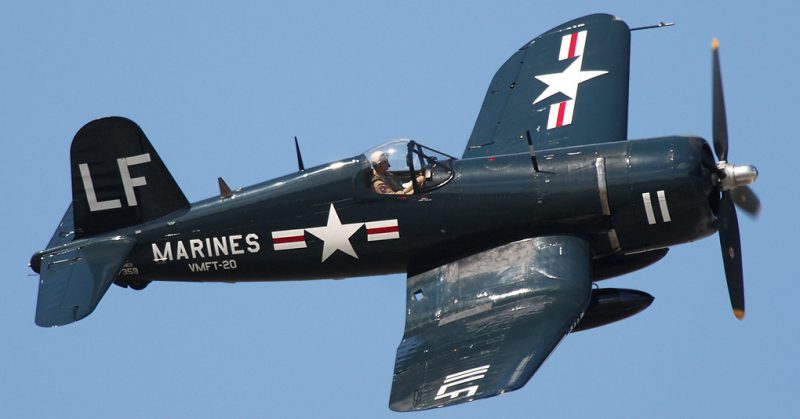Michele Spry was looking for a veteran pilot from World War II to interview for a children’s book she was writing in 2014. She is also the co-owner of Midway Electric in Columbia, Missouri.
Lt. Col. Ferrill is a retired Marine fighter pilot who flew in the Pacific theater of WWII. He needed a lamp repaired.
When he walked into Midway Electric, Spry saw his “Corsair F4U” hat and asked if he was a veteran. Their lives have been intertwined ever since.
Purdy flew a Corsair F4U fighter plane in his two tours of duty. Spry holds a deep respect for veterans of the WWII generation.
Since that meeting, Spry had her book published. She helped Purdy reunite with his wingman and assisted him when he applied for his two Purple Hearts. She recently discovered Purdy’s Corsair is in a museum in California and she is actively working to reunite the two.
It started as a project to write a children’s book about a pilot in WWII. It has become a friendship that has developed from her interest in Purdy’s nearly forgotten career.
Purdy was nineteen years old and on a hunting trip on December 7, 1941, so he didn’t hear about Pearl Harbor until the next day.
When he did hear, he immediately boarded a train to Kansas City so that he could enlist as a Navy pilot.
About two years later, he was a fighter pilot in the Marines and serving in the Pacific Theater. He recalls those years clearly with only a few missing details. His two tours in the Pacific were from 1943 to 1944 and from 1944 to 1946.
He was fighting in the Battle of Tarawa in November 1943, considered one of the bloodiest battles for both the Japanese and the US. 1,696 US soldiers and 4,690 Japanese soldiers lost their lives.
Eighteen months later, he was flying near Nagasaki when he and the pilots with him received the order to turn around. The US was about to drop the atomic bomb on Hiroshima.
45 days after the attack on Hiroshima, Purdy and some of his fellow soldiers in his squadron drove through the ruins of the city, curious as to what had occurred.
His wife, Elouise, says, “They didn’t necessarily understand the after effects back then.”
Purdy’s wingman in both tours was Major John Tashjian. Purdy speaks of Tashjian with respect. The wingman saved his life once.
It happened in 1944. While flying over the Marshall Islands, the oil cooler on their plane took a hit. Purdy managed to land the plane safely on the water, six nautical miles away from the shore.
Tashjian flew in circles over Purdy to keep the enemy away while two other pilots found a Navy destroyer which came and rescued Purdy. By this time, he was only 12 nautical miles from shore, with the enemy waiting.
That act of heroism cemented the friendship between Purdy and Tashjian during the war.
Purdy was shot down once more during his second tour in 1945 near Okinawa in the belly of his plane, sending shrapnel into his face, arm and legs. It also cut a tendon in his hand, forcing him to land the plane in a field with broken landing gear and only one hand to fly with.
After recuperating from his injuries and wrapping up his tour of duty, he went back home to Bosworth, Missouri, in 1946 for good. He finished college and then he moved to Columbia where he taught pharmacology and physiology.
Spry’s plan was to interview a WWII pilot going on an Honor Flight for the first time. She kept asking Purdy to apply for the flight, but he always declined, citing his poor health. Finally, he offered to tell her his story if she would stop pestering him about the Honor Flight.
She self-published the book in July, but she couldn’t get Purdy’s story out of her head. In the spring, she began to look for his wingman, Tashjian.
After weeks of searching, she contacted Tashjian’s son who told her that his father, now 95, was alive and traveling in Australia.
Three weeks later, Tashjian called Spry to tell her he’d be in St. Louis at the end of June. Spry arranged for him to be driven to Columbia to see Purdy. The weekend was emotional for all involved.
“I thought I was never gonna see John again,” Purdy said. “All the other friends I flew with are gone.”
Spry has also worked with Purdy to apply for Purple Hearts for each time he was wounded in the war. They submitted the paperwork to US Rep. Vicky Hartzler in June.
That same month, Spry took the serial number from one of Purdy’s logbooks and found that the plane he flew was on display at the Planes of Fame air museum in Chino, California.
She has started a GoFundMe campaign to raise the $28,000 required to bring the plane to Columbia. She met that goal recently, Columbia Missourian reported.
The plane was in Columbia on October 15 for a free public event.
Spry said that Purdy was excited to “pat the belly of that plane one more time.”
